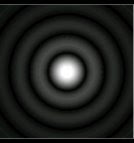
So, basically, all forms of energy are flowing around us all the time (how did you think the radio signals get to your car?). They are stronger if you are closer to an energy source (like if you were right next to the radio tower).
Electricity is the flow of electrons; it is just energy. Though the electrons themselves are contained in the wire, their flow produces an energetic field around the wire itself. Flourescent lights work because an electric field passing through them adds energy to the atoms inside which become 'excited' and then emit light (the physics of this is a little complex and would require a more lengthy explanation...). Normally this is provided by voltage from a wire, but the field under a high power line is enough to excite these atoms.
So the fluorescent tubes glow. Probably much less than they would when powered from the mains, and therefore only visible after dark. Why isn't it dangerous? Electrical danger comes from both voltage AND current (flow). In other words, water contained behind the Hoover Dam is fine, but if it flows.... The current inside the tubes is very low; about the same as causes a spark after you scuff your feet on the carpet. So you can safely hold the tube in your hand and see it light. If you've ever been to a science museum and touched the silver ball that makes your hair stand on end you've experienced a high voltage at low current. A flourescent tube would light if you held it near one of these when it was on.
Interesting history: in looking this up on the web I found that many people already knew this trick:
"It is an old farmer's trick here in the States to conceal a coil underneath power transmission lines to run small irrigation pumps where no other power is available..."
Electricity is the flow of electrons; it is just energy. Though the electrons themselves are contained in the wire, their flow produces an energetic field around the wire itself. Flourescent lights work because an electric field passing through them adds energy to the atoms inside which become 'excited' and then emit light (the physics of this is a little complex and would require a more lengthy explanation...). Normally this is provided by voltage from a wire, but the field under a high power line is enough to excite these atoms.
So the fluorescent tubes glow. Probably much less than they would when powered from the mains, and therefore only visible after dark. Why isn't it dangerous? Electrical danger comes from both voltage AND current (flow). In other words, water contained behind the Hoover Dam is fine, but if it flows.... The current inside the tubes is very low; about the same as causes a spark after you scuff your feet on the carpet. So you can safely hold the tube in your hand and see it light. If you've ever been to a science museum and touched the silver ball that makes your hair stand on end you've experienced a high voltage at low current. A flourescent tube would light if you held it near one of these when it was on.
Interesting history: in looking this up on the web I found that many people already knew this trick:
"It is an old farmer's trick here in the States to conceal a coil underneath power transmission lines to run small irrigation pumps where no other power is available..."
"A simple test for a portable radio transmitter (typically ~ 2W) is to bring the antenna close to a fluorescent tube lamp. If the lamp lights when the transmit button is pressed, it is a useful indication that the transmitter is working..."


No comments:
Post a Comment